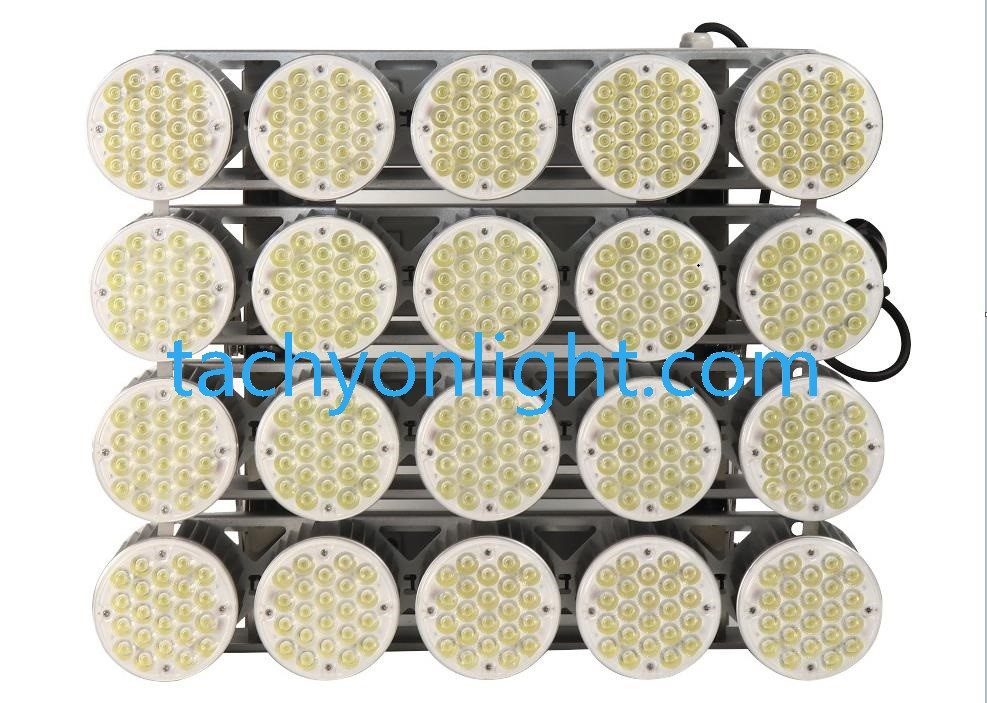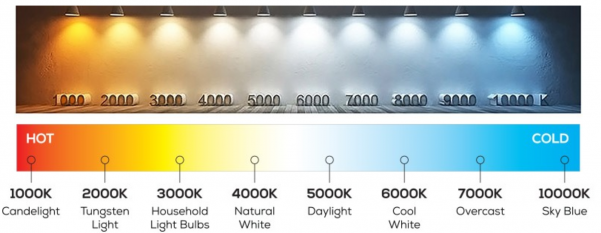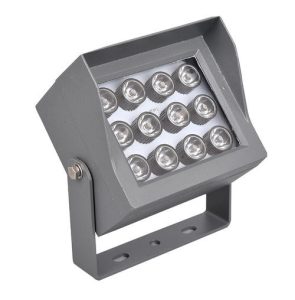Definition of color temperature:
When the color of the light emitted by the light source is the same as the color of the black body at a certain temperature, the temperature of the black body is called the color temperature of the light source.
Introduction to color temperature
Because most of the light emitted by the lighting source is white light, the color table temperature or correlated color temperature of the light source is used to refer to the relative whiteness of the light color, in order to quantify the light color performance of the light source. According to Max Planck’s theory, heating a standard black body with complete absorption and radiation ability, the temperature gradually increases and the luminosity changes accordingly; the black body locus on the CIE color coordinate shows that the black body is red-orange-red- Yellow-yellow-white-white-blue-white process.
The temperature at which the black body is heated to the same or close to the light color as the light source is defined as the correlated color temperature of the light source, called the color temperature, in absolute temperature K (Kelvin, or Kelvin temperature) as the unit (K=℃+273.15) . Therefore, when the black body is heated to a red color, the temperature is about 527°C or 800K, and its temperature affects the change of light color.
The more bluish the light, the higher the color temperature, and the redder the lower the color temperature. The color of light in a day also changes with time: 40 minutes after sunrise, the light color is yellower and the color temperature is about 3,000K; the sun is white at noon, rising to 4,800-5,800K, and it is about 6,500K at noon on cloudy days; the light color before sunset Reddish, the color temperature drops to about 2,200K.
Because the correlated color temperature is actually the evaluation value of the light color performance of the light source when the black body radiation is close to the light color of the light source, it is not an accurate color contrast, so two light sources with the same color temperature may be in the appearance of the light color. There are still some differences. The color temperature alone cannot know the color rendering ability of the light source, or the degree of color reproduction of the object under the light source.
Correlated color temperature of different light source environments
| Light source environment | CCT (K) |
| cloudy day | 6500~7500 |
| Summer noon sun | 5500 |
| Metal halide lamp | 4000~4600 |
| Afternoon daylight | 4000 |
| Cool fluorescent lamp | 4000~5000 |
| High-pressure mercury lamp | 3450~3750 |
| Warm fluorescent lamp | 2500~3000 |
| Halogen lamp | 3000 |
| Tungsten lamp | 2700 |
| HPS | 1950~2250 |
| Candle light | 2000 |
| Northern clear sky | 8000~8500 |
| LED Light | 2000~15000 |
How to choose the correct color temperature of home LED bulbs
Buying LED bulbs seems like a daunting task. When you are faced with so many choices, whether you need cool, warm or neutral color temperature LEDs, it depends on how and when you use your home, as well as the interior style and material.
The following 5 questions will make it easier for you to choose a suitable LED light.
- When is your favorite time to be at home?
If you are at home most of the time at night, then a warmer color temperature, such as 2700K LED fluorescent light, may be the best choice, which will make you more relaxed, less likely to disrupt your sleep style, and will provide the traditional 60 watts Similar brightness to incandescent bulbs.
- When do you like to use your lighting best?
A 5000K LED fluorescent lamp may be a good idea for an office you use mainly during the day, but if your windows have enough daylight to enter, please consider using a bulb with a higher color temperature instead of being more comfortable at night.
- What color do your walls, floors, ceilings and furniture have?
If the home is full of cool colors, such as black, blue, green or crisp white, warm colors such as 3000K or even 3500K LED bulbs may be the best choice for your decoration.
But if you have a lot of natural materials, such as hardwood floors or cabinets, woven carpets and brown, tan, red or orange interiors, warm white like 2700K LED bulbs may improve your home atmosphere.
- What is the style of your home?
Under the warm white of 2700K LEDs, traditional and transitional homes usually look best because they produce light that is closer to candlelight, firelight, and gas lamps used in classic houses.
Some modern homes, especially those with white finishes, may look better, while light bulbs are closer to the colder side of the temperature scale. But remember that even in a modern home, you need light to help you relax at night, so a warm light bulb is still the best choice for the bedroom.
- Are you getting darker?
Classic incandescent bulbs tend to dim easily, and will produce a warmer amber color when you do. The first batch of LEDs on the market were not dim, which is one of the reasons why some people dislike them. Manufacturers are now making “warm and dim” LEDs, as low as 1600K when dimmed, emitting a more traditional incandescent light.
Ideally, our light will change throughout the day, just like the sun. We can recreate the pattern with some new LED lamps called “adjustable white”. These new products allow us to obtain the cool white of daylight when the daylight matches the natural light, thus providing us with the most energetic and active atmosphere, which is what we need. As the sun goes down, the adjustable white bulbs are transformed into traditional incandescent bulbs, making it easier for us to relax and sleep.
How to choose the color temperature of car led headlights
Due to the difference in color temperature, the color of light is also different. For example, when the color temperature is 4300K, the color of light is white with a little yellow; when the color temperature is 6000K, the color is white and close to natural light; when the color temperature is 10000K, the light The color is light blue, which shows that with the gradual increase of color temperature, the color of light gradually shifts to cool color, which is often called cold light.
The color temperature of a halogen lamp is 3000K, and the color is yellow, and the color temperature of a xenon lamp is 4300K or above, and as the color temperature increases, the color gradually turns blue or even pink. Maybe you will find it a bit confusing to understand, but you just have to remember: color temperature is not a unit representing brightness, which means that color temperature has nothing to do with brightness.
If the color temperature is too high, it will appear bluish (higher will appear purple). Lights with this color temperature have very poor penetration in hazy weather, so the situation is that you cannot see the road conditions outside in the car. The driver or pedestrian on the opposite side is stunned by you. This is very easy to cause safety problems. Therefore, when choosing xenon lights, never choose too high color temperature to make your car look cooler, regardless of modification laws. This is not only for your own safety, but also responsible for the safety of others.
Should the car lights be the brightest? not quite. The bright blue light not only can not improve the good lighting effect for you, but may also cause unnecessary traffic accidents. This is because the light produced by different light sources has different color temperatures. The penetrability of different color temperatures is different. For example, light with a color temperature above 7000K can hardly penetrate haze and dust, which will affect the driver’s sight and easily cause traffic accidents.
As many car owners pay more and more attention to driving safety, most car owners choose to upgrade LED headlights to replace halogen headlights, because LED headlights have high brightness, long life, super energy saving, and more stable advantages, which promote LED cars Lights have become an alternative to halogen headlights. If you consider using color temperature to optimize the lighting of your car lights, here is everything you need to know.
How to choose the color temperature of car lights?
Color temperature only indicates the spectral components of the light source, not the luminous intensity. But the color temperature directly affects the brightness and contrast. At the same time, the color temperature has a great relationship with the human eye’s perception of light color. Let’s compare the lighting effects of different color temperatures.
3500K halogen headlights have the lowest color temperature and yellow light. For night driving, not only the lighting brightness is not enough, but also the driver’s fatigue is increased, which is not conducive to safe driving at night. The 5500K LED headlights are white light, which can reach the safe illumination range of driving at night, and the human eye looks more comfortable. 7000K xenon headlights, the bright white light is obviously with blue light, the illumination range has been improved, but the penetration is extremely poor.
Considering factors such as brightness and penetration, we recommend using LED car lights with a color temperature between 5500K-6500K, which can meet the needs of night driving lighting without worrying about the penetration of rain and fog.
So choosing the right color temperature of the car lights is as important as choosing the brand of car lights.







